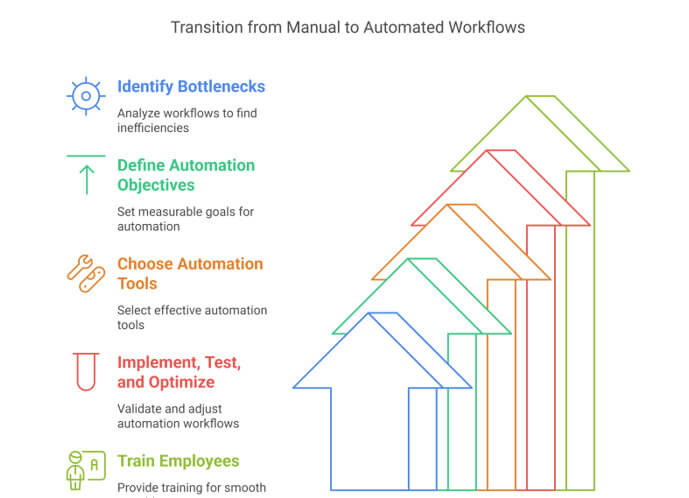- March 4, 2025
McKinsey claims that nearly 50%, if not more, of all work activities today could be automated using technology that is already available, liberating power and potential for productivity and efficiency never before seen.
Equally compelling are the results from companies that have automated to the tune of cost reduction by 30% and an increase in operational efficiency of 25%.
But the focus is not merely on reducing costs. Rather, automation offers companies the opportunity to focus on repetitive tasks, enhance decision-making aided by real-time data, and improve the customer experience through faster response.
You might think of anything from AI-enabled customer service to automated supply chain management.
With the global automation market expected to hit $265 billion by 2025, strategies to adoption of automation have shifted from ‘if’ to ‘how fast’ it can create growth, innovation, and sustainable success for businesses.
This blog brings you the significance of transforming business operations with AI, and how the future belongs to one who automate!
Are you ready to lead the charge?
Common Challenges of Manual Business Operations
- Lack Of Efficiency and Consumption of Time: The manual processes are monotonous and lack efficiency most of the time. They end up eating into employees' productive hours spent on non-automatable tasks such as entering data or approvals or making reports.
- Rates of Increased Errors: Errors caused by human intervention are unavoidable during manual operations. A few minor erroneous entries or calculations can cause expensive inaccuracies, compliance issues, or harm to client relationships.
- Increased Operational Cost: Manual workflows can consume more resources, whether human, time, or matter. As time goes on, these begin to increase operational costs and have the spine to reduce the organization's functioning properly by scale without efficiency.
- Scalability Problem: Growth usually causes a business to suffer in manual processing. Scaling operations without automation often depends on adding more staff, resulting in increased overhead without assurance of efficiency. Therefore, higher chances of unauthorized entry, loss of documents, or data breaches exist because of keeping information in manual custody.
- Missing Genuine Real-Time Insights: One of the reasons why organizations sometimes are slow to collect real-time data for decision-making is due to old and manual systems. With the failure of companies to have timely insights, they can only risk being the last in the race against competitors who can react faster to changes in the marketplace.
- Delayed Response to Market Changes: Manual processes slow a business, making it hard for it to adapt quickly to contemporary trends, customer demands, or technological advancements.
Key Business Functions That Benefit from Automation
- IT & Infrastructure Management: With the introduction of IT automation services, businesses can simplify repetitive tasks such as system observation, software updating, and cybersecurity. Such improvements are reliability among systems, minimization of human errors, as well as shifting the IT teams to focus their efforts on driving strategic growth rather than wasting time on manual troubleshooting.
- Customer Service: Robotic Process Automation (RPA) enhances customer service through automation of repetitive queries and ticketing management and then provides a means through which fast resolution of problems can be identified through AI empowerment of chatbots. The idea is that there will now be 24/7 availability of support with reduced response times and improved buyer satisfaction while freeing human agents of repetitive problems
- Finance & Accounting: Business process automation has streamlined operations in finance with workflows such as automated invoicing and expense tracking, payroll management, and compliance reviewing. In general, this causes errors to decrease and speed up financial reports. Besides, real-time financial views enable better decision-making.
- Human Resources: Integrating workflow automation helps HR teams simplify the recruitment process, onboarding, leave approvals, and performance tracking.By automating all these tasks, efficiency is enhanced while HR professionals focus more on the company culture and employee development.
- Sales & Marketing: Workflow automation helps to personalize marketing campaigns and automating e-mailing nurture leads and managing content on social media efficiently. All these bring forth increased productivity and better customer conversion rates through automated CRM updates and follow-up reminders for sales teams.
Steps to Transition from Manual to Automated Workflows

- Identify Bottlenecks in Current Processes: In other words, the core requirement to automate business processes, first analyze workflows to see where the ongoing inefficient delays or repetitive work exist.More pain-points are identified, and organizations can decide which processes will lend themselves to AI-driven automation and intelligent automation solutions.
- Define Clear Automation Objectives: Set clear and understandable, measurable objectives for automation-strategy goals whether cutting processing time or increasing accuracy or scalability. This means integrating these objectives into enterprise automation strategies-system-wide.
- Choose the Right Automation Tools: It is essential to select the most effective combination of cloud-based automation and AI-enabled automation tools. Promising candidates include platforms for business process automation, robotic process automation (RPA), and intelligent document processing relevant to your business needs.
- Implement, Test, and Optimize: Pilot phase for validating automation workflows against real conditions in actual scenarios. Tracking performance. Using feedback to adjust before scaling up. Continual measurement makes sure intelligent automation solutions will gain efficiency and accuracy.
- Train Employees for a Smooth Transition: Because automation is a part of the enterprise, it must be accepted by the employees. Always do hands-on training so that the team will understand a little better how to work alongside automation processes. Trained professionals can mobilize this AI-based automation to carry maximum business impact.
Key Benefits of Business Process Automation

- Enhanced Efficiency & Productivity: Through process automation, companies eliminate repetitive manual undertakings, reduce the need for manual intervention, and speed up workflow in organizations. AI-based automation enables unprecedented processing times for teams to dedicate their effort to value-adding works that enhance business growth.
- Cost Reduction and Resource Optimization: Intelligent process automation even cuts costs in production, bringing down errors arising from human involvement, unclogging workflows, and optimizing resource use. Automation at the enterprise level further enhances increase in operation without a need to inject more workforce into the system.
- Improved Accuracy and Compliance: Manual errors lead to inefficiency in compliance risks. Cloud-based automation ensures that data is accurate, processes are standardized, and compliance is regulated due to maintaining strong audit trails.
- Seamless Scalability and Flexibility: As an organization grows, with the enterprise automation an organization will grow without compromising its operation. The flexibility provided by cloud-based automation solutions gives remote access and system integration and processing adjustments to be made according to the changing business needs.
- Better Decision-Making through Real-time Insight: AI-based automation normally collects and analyzes huge kinds of data in real time and offers actionable insights. This allows organizations to make data-driven decisions in greater speed while improving operational agility and competition.
- Improving Customer Experience: Businesses can respond faster, personalize customer interactions, and make service delivery much more seamless with intelligent automation solutions. Chatbots, automated ticketing systems, and AI-powered support improve customer satisfaction and loyalty.
Overcoming Common Automation Challenges
- Resistance to Change: Employees fear AI-driven automation will take over their jobs. To make the transition smoother, companies should focus on upskilling their workforce and promoting intelligent automation solutions that enhance productivity rather than replacing jobs.
- Choosing the Right Automation Tools: Wrongly chosen business process automation tools may bring inefficiency. The need of the hour is to evaluate a company`s requirements, test different cloud-based automation solutions, and imbibe a scalable methodology for implementation.
- Integration with Legacy Systems: Due to the outdated infrastructure, many organizations face the challenge of integrating enterprise automation. A well-thought-out strategy of modernizing legacy systems, combined with API-driven intelligent automation solutions, would guarantee seamless interoperability.
- High Implementation Costs: Automation is an initial investment, but the returns in terms of cost-saving are far-reaching. Companies should do small deployments, kick off with cloud automation, and gradually scale it based on the analysis of returned investments.
- Ensuring Data Security & Compliance: Automated processes deal with vast amounts of sensitive data, making security and compliance paramount. Businesses should apply stringent cybersecurity procedures, comply with necessary regulations, and leverage AI-driven automation to track and control risks.
Conclusion
Artificial Intelligence-based automation and cloud-based orchestration are pushing organizations to experience performance unmatched by anything that has been encountered before, alongside savings and competitive advantages.
Intelligent automation means the future of enterprise automation. Integrated with AI, machine learning, and robotics, intelligent automation will lead to smarter self-optimizing workflows. Organizations adoption of automation today would, however, ensure future-proofed operations and remain ahead.
Happy Learning!!
FAQs
Which business functions benefit the most from automation?
Business processes are automated and improve efficiency and accuracy in IT management, customer service, finance, HR, and sales.
What challenges do companies face when implementing automation?
Companies face challenges ranging from legacy systems integration, excessive costs, security issues, and employee resistance, requiring a well-thought-out strategy along with appropriate intelligent automation solutions.
How does automation impact employee roles?
Automation at the enterprise level alleviates employees from mundane jobs, allowing them to engage in more strategic work, increasing productivity and stimulating innovation.
How can Hexacorp help businesses automate their operations?
HexaCorp automates AI-driven and cloud automation solutions to empower businesses to optimize workflow and achieve seamless digital transformation.




